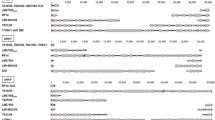Abstract
Enteroaggregative Escherichia coli (EAEC) is an increasingly important cause of diarrhea in both developing and industrialized countries, and is characterized by strong biofilm formation on the intestinal mucosa. Sequencing of the virulent plasmid pAA2 of the prototype EAEC 042 revealed a cluster of three open reading frames (ORFs; shf, capU, and virK) ca. 93% identical to a similar cluster located in Shigella flexneri. The function of the first ORF Shf protein is not known, but the closest well-characterized homologue is the IcaB protein of Staphylococcus epidermidis, which plays a crucial role in exopolysaccharide modification in bacterial biofilm formation. To investigate the role of this cluster in the virulence of EAEC, we mutated three genes at this locus. All the mutants maintained the aggregative phenotype in the liquid phase. However, the insertional mutant of shf formed a less abundant biofilm in a microtiter plate assay than did the wild type, while the capU mutant and the virK mutant did not. The complementation of the shf mutant with this cluster restored the thick biofilm similar to that of the wild type. The shf transcriptional level decreased in the transcriptional regulator aggR mutant and was restored when the mutant was complemented with aggR. These results suggest that the shf gene is required for the firm biofilm formation of EAEC 042, and transcription of the shf gene is dependent on AggR.




Similar content being viewed by others
References
Barua S, Yamashino T, Hasegawa T et al (2002) Involvement of surface polysaccharides in the organic acid resistance of Shiga toxin-producing Escherichia coli O157:H7. Mol Microbiol 43:629–640
Cohen MB, Nataro JP, Bernstein DI et al (2005) Prevalence of diarrheagenic Escherichia coli in acute childhood enteritis: a prospective controlled study. J Pediatr 146:54–61
Czeczulin JR, Whittam TS, Henderson IR et al (1999) Phylogenetic analysis of enteroaggregative and diffusely adherent Escherichia coli. Infect Immun 67:2692–2699
Dudley EG, Thomson NR, Parkhill J et al (2006) Proteomic and microarray characterization of the AggR regulon identifies a pheU pathogenicity island in enteroaggregative Escherichia coli. Mol Microbiol 61:1267–1282
Harrington SM, Dudley EG, Nataro JP (2006) Pathogenesis of enteroaggregative Escherichia coli infection. FEMS Microbiol Lett 254:12–18
Heilmann C, Schweitzer O, Gerke C et al (1996) Molecular basis of intercellular adhesion in the biofilm-forming Staphylococcus epidermidis. Mol Microbiol 20:1083–1091
Kahali S, Sarkar B, Rajendran K et al (2004) Virulence characteristics and molecular epidemiology of enteroaggregative Escherichia coli isolates from hospitalized diarrheal patients in Kolkata, India. J Clin Microbiol 42:4111–4120
Nakata N, Sasakawa C, Okada N et al (1992) Identification and characterization of virK, a virulence-associated large plasmid gene essential for intercellular spreading of Shigella flexneri. Mol Microbiol 6:2387–2395
Nataro JP, Kaper JB, Robins-Browne R et al (1987) Patterns of adherence of diarrheagenic Escherichia coli to HEp-2 cells. Pediatr Infect Dis J 6:829–831
Nataro JP, Mai V, Johnson J et al (2006) Diarrheagenic Escherichia coli infection in Baltimore, Maryland, and New Haven, Connecticut. Clin Infect Dis 43:402–407
Nishi J, Sheikh J, Mizuguchi K et al (2003) The export of coat protein from enteroaggregative Escherichia coli by a specific ATP-binding cassette transporter system. J Biol Chem 278:45680–45689
Okeke IN, Nataro JP (2001) Enteroaggregative Escherichia coli. Lancet Infect Dis 1:304–313
Rajakumar K, Luo F, Sasakawa C et al (1996) Evolutionary perspective on a composite Shigella flexneri 2a virulence plasmid-borne locus comprising three distinct genetic elements. FEMS Microbiol Lett 144:13–20
Sheikh J, Hicks S, Dall’Agnol M et al (2001) Roles for Fis and YafK in biofilm formation by enteroaggregative Escherichia coli. Mol Microbiol 41:983–997
Sheikh J, Dudley EG, Sui B et al (2006) EilA, a HilA-like regulator in enteroaggregative Escherichia coli. Mol Microbiol 61:338–350
Sheikh J, Czeczulin JR, Harrington S et al (2002) A novel dispersin protein in enteroaggregative Escherichia coli. J Clin Invest 110:1329–1337
Vuong C, Kocianova S, Voyich JM et al (2004) A crucial role for exopolysaccharide modification in bacterial biofilm formation, immune evasion, and virulence. J Biol Chem 279:54881–54886
Wakimoto N, Nishi J, Sheikh J et al (2004) Quantitative biofilm assay using a microtiter plate to screen for enteroaggregative Escherichia coli. Am J Trop Med Hyg 71:687–690
Zamboni A, Fabbricotti SH, Fagundes-Neto U et al (2004) Enteroaggregative Escherichia coli virulence factors are found to be associated with infantile diarrhea in Brazil. J Clin Microbiol 42:1058–1063
Imuta N, Nishi J,Toukda K et al (2007) Escherica coli efflux pump TolC promotes aggregation of enteroaggregative E. coli 042. Infect Immun 75(3), (in press) [Epub ahead of print]
Acknowledgments
This study was financially supported by Grant-in-Aid for Scientific Research (C) No. 17591098 from the Ministry of Education, Culture, Sports, Science, and Technology, Japan. We thank Professor H. Oda of Kagoshima University, Japan, for helpful discussion.
Author information
Authors and Affiliations
Corresponding author
Rights and permissions
About this article
Cite this article
Fujiyama, R., Nishi, J., Imuta, N. et al. The shf Gene of a Shigella flexneri Homologue on the Virulent Plasmid pAA2 of Enteroaggregative Escherichia coli 042 Is Required for Firm Biofilm Formation. Curr Microbiol 56, 474–480 (2008). https://doi.org/10.1007/s00284-008-9115-y
Received:
Accepted:
Published:
Issue Date:
DOI: https://doi.org/10.1007/s00284-008-9115-y




